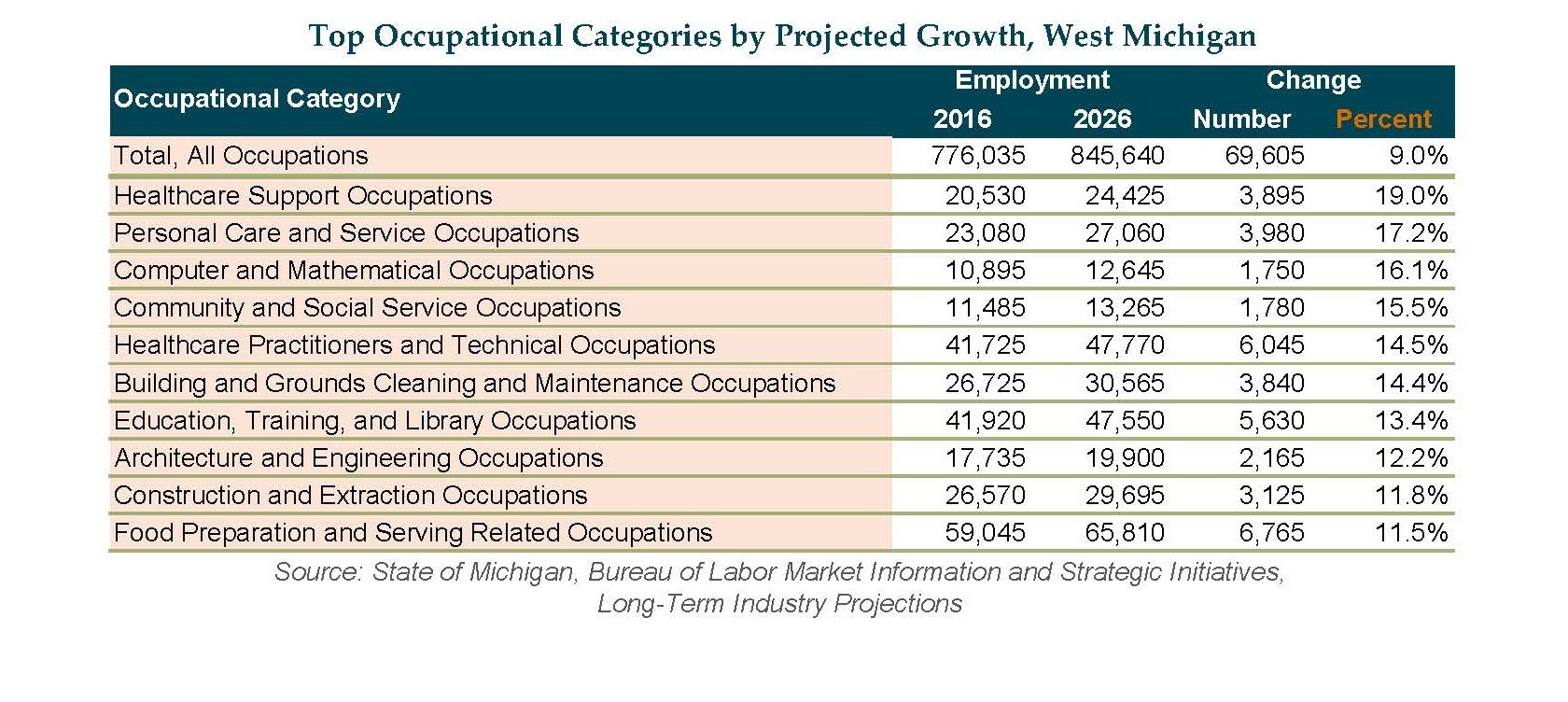Last Thursday, the State of Michigan’s Bureau of Labor Market Information and Strategic Initiatives released their regional employment projections for all occupational categories over the 2016-2026 period. These projections are calculated every two years and give us a great opportunity to peek into the future of the regional labor market, particularly by illuminating the job families where West Michigan residents should expect higher-than-average occupational growth, labor force exits, and even occupational transfers.
Occupational categories with expected growth
The economy is divided into 22 distinct occupational categories. While all but one of them are expected to grow statewide through 2026, anticipated growth appears much different when assessing high-growth occupations just in our 13-county West Michigan region.

With respect to the West Michigan economy, employment growth is projected to be 9.0 percent through 2026, an addition of over 69.5 thousand jobs. Anticipated employment growth for fifteen occupational categories in West Michigan exceed the aggregated growth rate for all occupations across the region, including Healthcare Support Occupations (19.0 percent), Personal Care and Service Occupations (17.2 percent), Computer and Mathematical Occupations (16.1 percent), Community and Social Service Occupations (15.5 percent) and Healthcare Practitioners and Technical Occupations (14.5 percent). Many of these occupational categories also rank near the top in terms of numeric job growth through 2026, which also includes Transportation and Material Moving Occupations, which is expected to add over 6.5 thousand jobs.
Specific occupations with rapid growth
Looking specifically at detailed occupations, the top 10 expected to grow the fastest are perhaps emblematic of where the economy is expected to go in the long run, reflecting trends in Data Security and Health Care spurred by digitization and the aging of the American population. When ranked by percentage growth, six of the top ten fastest-growing occupations in our region are related to Healthcare and Social Assistance. Home Health Aides leads in this category, with an expected employment growth of 47.6 percent, trailed by Physician Assistants (33.9%), Personal Care Aides (33.0%), and Nurse Practitioners (32.2%). Additionally, three technical occupations round out the top ten, including Statisticians (47.6 percent), Information Security Analysts (34.6%), and Software Developers, Applications (33.8 percent).
The occupations expecting the highest numeric growth (which already trend in favor of high-volume occupations) include Combined Food Preparation and Serving Workers, Including Fast Food (+3,155 jobs), Laborers and Freight, Stock, and Material Movers (+2,285 jobs), and Registered Nurses (+2,165 jobs).
Technical Note
Projections data are available on the industry and occupation level, although this post focuses on the occupational side. Industries represent the classification of the employer, whereas occupations are defined for individual employees.
What’s Next?
The latest West Michigan Talent Assessment and Outlook report is scheduled for release in Early September and will include these new regional occupational projections out to 2026 for each industry cluster identified in the report. This will give an in-depth view at the occupations and industries expected to grow during that time.


